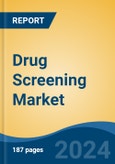Urine Samples is the fastest growing segment, North America is the largest market globally
Speak directly to the analyst to clarify any post sales queries you may have.
10% Free customizationThis report comes with 10% free customization, enabling you to add data that meets your specific business needs.
Key Market Drivers
The global drug screening market is significantly influenced by the escalating rates of substance abuse worldwide. As illicit drug use continues to rise, there is a corresponding surge in the demand for effective screening solutions across various sectors, including healthcare, workplaces, and criminal justice. This heightened prevalence of drug use necessitates robust detection methods to safeguard public health and maintain societal order. According to the UNODC World Drug Report 2024, the number of people who use drugs globally rose to 292 million in 2022, marking a 20 percent increase over the preceding decade. This trend directly fuels the need for expanded drug testing programs, driving both the volume of tests performed and the innovation required to detect a broader spectrum of substances.Key Market Challenges
The continuous emergence of novel synthetic drugs and designer substances presents a substantial impediment to the growth of the global drug screening market. These rapidly evolving compounds frequently bypass existing detection methodologies, requiring constant and significant analytical innovation from screening providers. This dynamic landscape compels market participants to dedicate substantial resources to ongoing research and development efforts, increasing operational costs and extending timelines for test kit validation and deployment.Key Market Trends
Technological advancements are profoundly influencing the global drug screening market by improving test speed, accuracy, and the range of detected substances. Innovations in analytical techniques are crucial, especially as attempts to compromise test integrity rise. The 2024 Quest Diagnostics Drug Testing Index reported tampered drug tests in the general U. S. workforce increased over six-fold in 2023 from the prior year, underscoring the demand for robust screening methods. This drives the development of advanced portable devices and laboratory platforms.Key Market Players Profiled:
- Quest Diagnostics Inc.
- Heska Corporation
- Thermo Fisher Scientific, Inc.
- Alfa Scientific Designs, Inc.
- OraSure Technologies, Inc.
- F. Hoffmann-La Roche Ltd
- MPD Inc.
- Shimadzu Corporation
- Lifeloc Technologies, Inc.
- Drägerwerk AG & Co. KGaA
- Premier Biotech, Inc.
- Omega Laboratories, Inc.
Report Scope:
In this report, the Global Drug Screening Market has been segmented into the following categories:By Product & Services:
- Drug Screening Product
- Analytical Instruments
- Rapid Testing Devices
- Oral Fluid Testing Devices
- Consumables
- Drug Screening Service
By Sample Type:
- Urine Samples
- Breath Samples
- Oral Fluid Samples
- Hair Samples
- Other Samples
By End User:
- Drug Testing Laboratories
- Workplaces
- Criminal Justice and Law Enforcement Agencies
- Hospitals
- Drug Treatment Centers
- Individual Users
- Pain Management Centers
- Schools and Colleges
By Region:
- North America
- Europe
- Asia Pacific
- South America
- Middle East & Africa
Competitive Landscape
Company Profiles: Detailed analysis of the major companies present in the Global Drug Screening Market.Available Customizations:
With the given market data, the publisher offers customizations according to a company's specific needs. The following customization options are available for the report:- Detailed analysis and profiling of additional market players (up to five).
This product will be delivered within 1-3 business days.
Table of Contents
Companies Mentioned
- Quest Diagnostics Inc.
- Heska Corporation
- Thermo Fisher Scientific, Inc.
- Alfa Scientific Designs, Inc.
- OraSure Technologies, Inc.
- F. Hoffmann-La Roche Ltd
- MPD Inc.
- Shimadzu Corporation
- Lifeloc Technologies, Inc.
- Drägerwerk AG & Co. KGaA
- Premier Biotech, Inc.
- Omega Laboratories, Inc.
Table Information
| Report Attribute | Details |
|---|---|
| No. of Pages | 187 |
| Published | November 2025 |
| Forecast Period | 2024 - 2030 |
| Estimated Market Value ( USD | $ 5.56 Billion |
| Forecasted Market Value ( USD | $ 7.58 Billion |
| Compound Annual Growth Rate | 5.3% |
| Regions Covered | Global |
| No. of Companies Mentioned | 12 |









